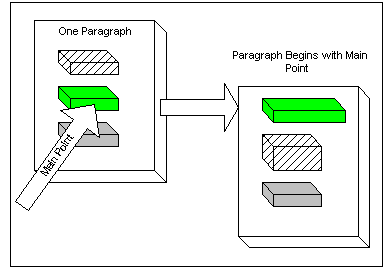Helps accurate comprehension. —Kieras
(1980)
Lets users decide whether to read or
skip. —Frisse(1987)
Several participants, while scanning
text, would read only the first sentence of the paragraph.
This suggests that topic sentences are important, as is
the "one idea per paragraph" rule. —Morkes &
Nielsen(1997)
A topic sentence states the
controlling idea of a paragraph; the rest of the
paragraph supports and develops that statement with
carefully related details.
The topic sentence is often the first
sentence because it states the subject the paragraph
is to develop. The topic sentence is effective in this
position because the reader knows immediately what the
paragraph is about.
—Brusaw et al (1997)
A writer has to make her message clear
at the beginning of each paragraph, and not try to
keep the reader in suspense. —Abeleto (1999).
For those who want to get more
information, you can back up the ideas in the rest of the
paragraph, giving more detail. —Bricklin
(1998)
Studies of printed text reveal that
readers perform better with a deductive organization—with
topic sentences appearing at the beginning of paragraphs
and important information being presented at the beginning
of a text (for example,
Dee-Lucas and Larkin 1990,
Kieras
1978; Lorch and Lorch 1985). Readers organize information
in long-term memory hierarchically, verifying topical
information faster and more accurately than detail
information (McKoon 1977,
Van Dijk and Kintsch 1983).
Deductive organization should aid readers in developing
these hierarchical frameworks. —Spyridakis(2000)
See bibliography:
Abeleto (1999),
Barstow & Jaynes (1986),
Bricklin
(1998),
Brusaw et al (1997),
Dee-Lucas and Larkin (1990),
Frisse
(1988a), Horton (1990),
Kieras (1978, 1980),
Lorch and Lorch (1985),
Mayer
(1992), McKoon (1977),
Morkes &
Nielsen
(1997),
Spyridakis (2000),
Van Dijk and Kintsch
(1983),
Williams (1990),
Young,
Becker, and Pike (1970).
Examples
Original Paragraph
When measuring the properties of
high-temperature superconducting crystals, in the
past, we have used Resonant Ultrasound Spectroscopy (RUS),
and we have also used it for nondestructive testing of
crystals, to discover imperfections in the crystal
structure, but we have now been able to repurpose this
diagnostic tool to apply it to monitor for cracks and
other flaws in commercial and military hardware such
as aircraft landing assemblies, helicopter rotor parts
and ball bearings, among military components, as well
as bombs and chemical munitions.
Revised Paragraph
We can now use Resonant Ultrasound
Spectroscopy (RUS) for nondestructive testing to
discover hidden cracks and other flaws in commercial
and military gear such as aircraft landing assemblies,
helicopter rotor parts, ball bearings, bombs, and
chemical munitions. Our research showed how to
repurpose this diagnostic approach, which had
previously been used to measure the properties of
high-temperature super-conducting crystals, and then
to discover imperfections in crystal structures.
Another Original Paragraph
Sometimes we go through a lengthy
period of preparation, during which we gather
information, think about the problem, and, perhaps,
try out some preliminary solutions. You have probably
observed yourself doing this on school projects. Much
early work on the way we think was similarly based on
self-observation. In 1926, for example, Wallas
published his classic The Art of Thought, in
which he summarized his reflections on the way he
himself thought that he thought—and backed up those
introspective analyses with autobiographical
narratives by other people. He saw four major phases
to thinking. You might be interested to know that
after the preparation phase came:
1) Incubation, during which
you put aside the problem to work on other
things, or sleep
2) Illumination, when the
solution appears in a flash
3) Verification, during
which you check the solution carefully to make
sure it works.
Another Revised Paragraph
Much early work on the way we think
was based on self-observation. In 1926, for example, Wallas published his classic The Art of Thought,
in which he summarized his reflections on the way he
himself thought that he thought—and backed up those
introspective analyses with autobiographical
narratives by other people. He saw four major phases
to thinking:
1) Preparation, during which
you gather information and make some
preliminary attempts to solve the problem
2) Incubation, during which
you put aside the problem to work on other
things, or sleep
3) Illumination, when the
solution appears in a flash
4) Verification, during
which you check the solution carefully to make
sure it works.


